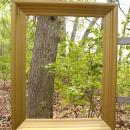With video: The River Project marries art and nature
Metal sprouts, gilded mirror frames, a knitted shadow, an abstract weathervane and a tiled Algonquin word now dot the landscape at Slocum’s River Reserve.
The third iteration of the River Project begins on June 20, marrying art with nature. After months of perfecting and crafting their designs, the artists’ installations are now nestled among the trees and tall grasses along the two miles of trails at the Reserve.
Artists were given a year to propose and develop their ideas, and during that time, the land was given time to heal from the previous exhibition, last held from 2012 to 2013.
The project is curated by the Dartmouth Natural Resources Trust and The Trustees of Reservations, the groups that co-manage Slocum’s River Reserve. The free outdoor exhibition will be on display through May 2016, and coincides with an indoor gallery.
“As part of The River Project, we have collaborated with Chris Gustin of Gustin Gallery, and he’s opened up his gallery for the artists to display some of their sketches, their diagrams, their concept thinking about the sculptures that have gone into place here,” said Jim Bride of the Dartmouth Natural Resources Trust.
Boston-based sculptor Matthew Hincman contributed a series of mirrored and empty frames, which have been installed throughout the woods.
“When I first proposed the project, I wanted to make sure that the objects were going to be durable in this space,” said Hincman. “We couldn’t use glass because it might break, I didn’t want to use plexiglass because it can get scratched and marred easily. And so the natural material to use was mirror polished stainless steel.”
The reflective surfaces are about 1/16 of an inch of mirror polished stainless steel that’s adhered to a piece of medium-density fiberboard.
“What’s beautiful about this is that the reflection is right there on the surface of the stainless steel as opposed to a glass mirror, where it’s a silver surface put on the back of the glass. You get the reflection from the front of the glass and then you get the reflection from the mirror. With this, it’s right there up front, so it’s crisp and clear. It’s a beautiful reflection,” he said.
He encourages hikers to take photos of themselves with his work and use the hashtag "River Project Frames (#riverprojectframes) on social media outlets as a way of gathering photos of visitors interacting with his work.
Jenine Shereos began developing her "Lacework" series in 2007 when she sat beneath a tree, tracing the shadows cast down by the branches. She developed a system of tracing the shadows around the tree, and used those sketches as a template.
After producing similar shadow sketches at Slocum’s River Reserve, she fashioned her outlines together and worked out how she could translate the paper pattern into a permanent installation.
“I knit the shadow out of tencel yarn and then painted it with a textile hardener. I then painted several layers of varnish over it to make the final piece weather-proof,” said Shereos.
When Isabel Mattia was in the designing phase of her project, a series of five metal, "semi-obstract" objects, she began by taking trips to the Reserve.
“I spent several months walking through this tract of land in different seasons. I’d seen it in past summers with other installations. I came back in the wintertime and scoped out different areas that I thought would be inspirational,” said Mattia.
She said she found many spaces throughout the Reserve that could have worked for her idea, but settled on an area where two paths converge into a triangle shape, giving viewers access to her work from multiple angles.
Mattia describes the five steel objects, which range from 85 to 250 pounds and required a pneumatic hand truck to install, as semi-abstract because they weren’t intended to represent a specific object.
“But, when people look at them, I get a lot of great representational interpretations. People say, ‘How’s your artichoke sculpture going?’ People say they look like shallots, eggs, seed pods — and I think those are references I like to think about and I see in the work, but to me they’re changing. Even what I refer to them as changes,” said Mattia.
“The landscape will change around the pieces, and the pieces will change into the landscape. I think that’s one of the beautiful parts of this project,” she said.































